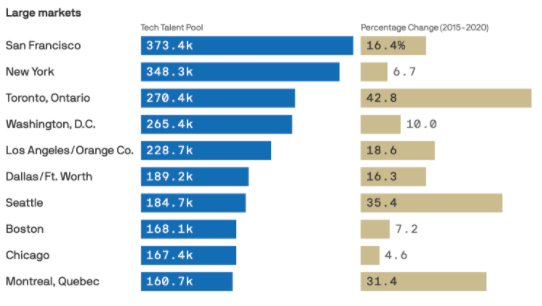
For some time, I’ve been looking for one “source” that curates modern takes on HR Tech, perspectives from the people who build it, and its impact on enterprise — something that’s tailor-made by professionals for decision-makers.
I never found it — so I decided to build it.
Every week, I’ll be sharing fresh insights on tech platforms, design, data, and the future of work — straight to your inbox.
My Thoughts
Here’s an interesting take on what NFTs (non-fungible tokens) can offer. Unlike traditional salaries, NFT technologies can measure micro-increments of individual contribution. 🤔🔲⛓️ As this author puts it: “If you can compensate each person for their exact contribution, you don’t need to pay everyone the same salary. And if every person gets paid for their contribution, those who are particularly productive or innovative will get paid more than ever.” This might work for certain companies depending on how they’re structured. But in the age of Agile, small-team work, it’s unlikely to drive value where it matters. Focusing on individual metrics can dis-incentivize collaboration. After all, impact and innovation are often the fruits of collaboration — not isolated acts of genius.
Tech Innovation at Work
I briefly mentioned Google’s $300 million investment into their cloud services last week. ☁️ 💸 📈 Here, a16z an takes in-depth look at the real costs of cloud-based infrastructure that many organizations don’t anticipate when making choices about IT. It looks at 50 of the top software companies and estimates how much profit is being eaten by the cost of their cloud (spoilers — it’s quite a lot). There’s more in the article about how infrastructure practice is damaging current and future values of companies.
Salesforce is expanding its low-code toolbox with the introduction of a new feature called Dynamic Interactions. 👩💻⚒️ 🔥 Approximately 150 drag and drop components will soon be available in the App Builder to connect Lighting pages without the help of a developer. Like other low code technologies, the new tool will help marketers compensate for the current shortage of web developers by empowering creative and business users without a tech background. 🎨 💼
“Remote is the new signing bonus,” according to Ladders founder Marc Cenedella. The past year has smashed our understanding of how (and where) we can work, and many employees are now choosing career opportunities based on flexible work accommodations rather than the biggest paycheck. 🐶 👨💻 💅 This has created an uptick in employee poaching. Companies are taking advantage of the large percentage of workers who would rather quit their current job than return to the office full time.

D.C.’s once powerful lobbying group Internet Association is shedding staff and restructuring. 🏛️ 🔨 This is part of a long pattern of the IA losing influence on Capitol Hill. 🌎❗📉 Margaret O’Mara, a Seattle-based researcher, says tech lobbying has entered a “company-driven” era in which more overarching advocacy groups are playing a diminished role. IA still boasts a roster of 41 member companies, including trillion-dollar colossuses Google, Amazon, and Facebook, although several of them are considering giving significantly less money to the group annually, according to two people familiar with the discussions. The group’s total revenue was around $10 million in 2019.
The Changing Workplace
Capital One Financial has announced that it will be transitioning to a hybrid work model, allowing employees to work remotely on Mondays and Fridays. CEO Richard Fairbanks wrote in a company-wide email: “We collectively discovered something remarkable during this pandemic. Remote work is not a niche opportunity. It works at scale in the mainstream.” 💪 👏 👩💻 Capital One is one of the many major organizations to adopt partial or fully-remote options for its employees as part of the radical shift in work culture we’ve seen this year. Fairbanks is one of a handful of CEOs to make a positive public comment about long-term hybrid & remote work models. Many are still in a wait-and-see stage about permanent remote work.
With major tech companies switching to WFH policies, what will become of the miles of offices in Silicon Valley? 🏄☁️ 🏓 Many are multi-million dollar buildings complete with onsite gyms, rooftop golf greens, and more. The amenities are attractive, but they’re unlikely to entice workers back to the office full time. It’s not clear yet whether companies will hang on to their real estate. On the bright side, with remote work, employees will have more options about where they can live — and where and for whom.

All About Data
The tech talent pool is growing — and here’s how it’s distributed geographically. Among the top 10 markets, markets with 150,000+ people, San Francisco and Toronto still boast the most workers. 📈 👩💻 ✈️ About 11% of the Bay Area workforce is in tech, and the same is true for Toronto. 3.8% and 3.7% or workers in New York and Los Angeles, respectively, are in tech. Several cities— large and small — saw huge gains in their tech talent pools in the last five years:
- Among the big metro areas, Toronto’s pool grew by 43%, Seattle’s by 35% and Montreal’s by 31%.
- Among the small ones, Orlando, Florida, saw a 30% gain; Nashville, Tennessee, 36%, and Edmonton, Canada, 53%.

CB Insights has also released their State of Venture Q2 2021 Report. 🔥 💵 📊 Here are some of the highlights:
- Global funding is up 157% year-over-year
- 136 billion-dollar companies were launched
- The top startup this quarter raised $3B
Click here to subscribe to Exit Interview, a weekly email about tech platforms, design, data, and the future of work — straight to your inbox.

